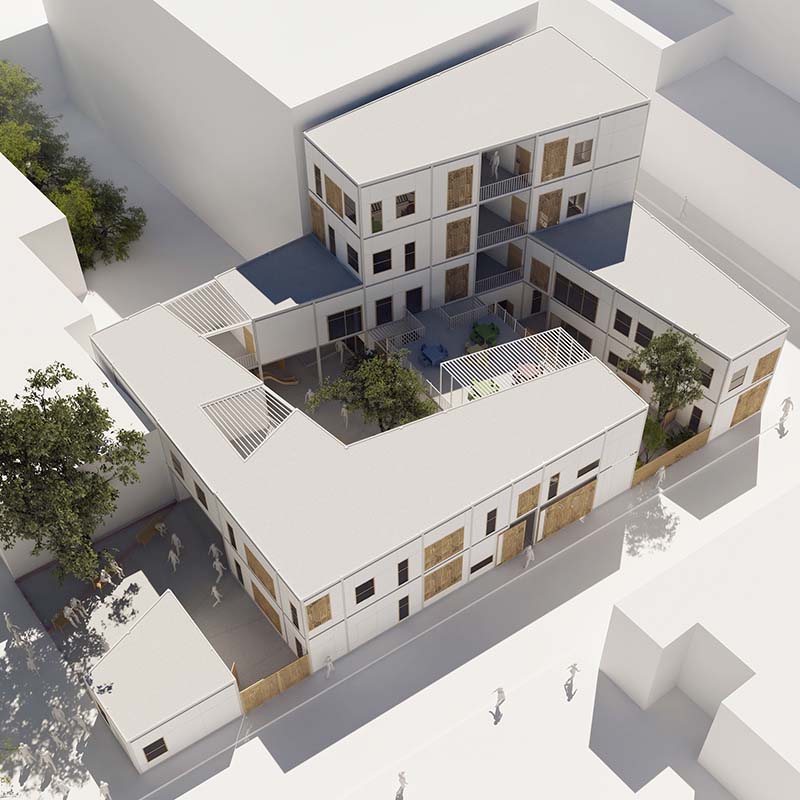

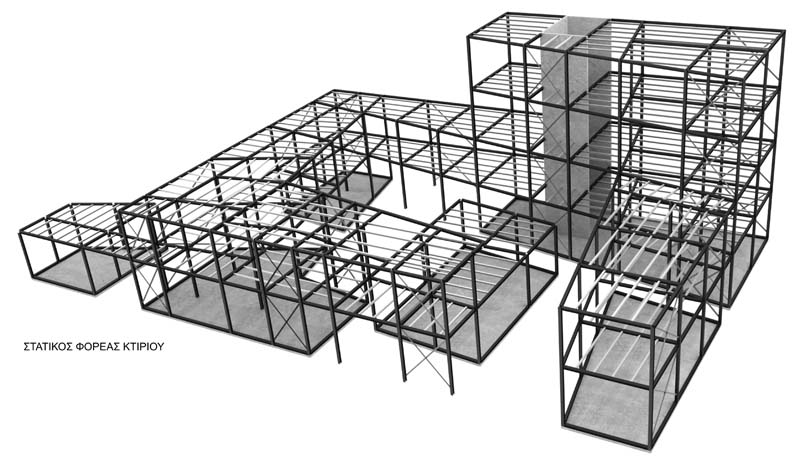



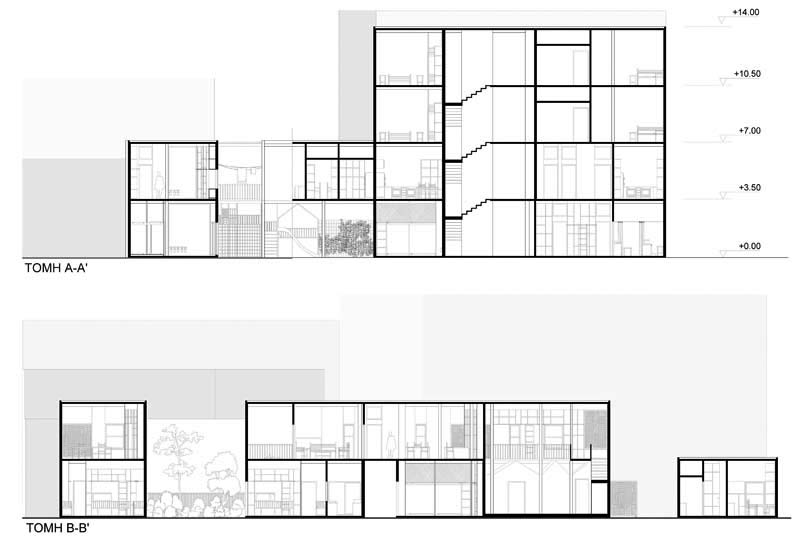



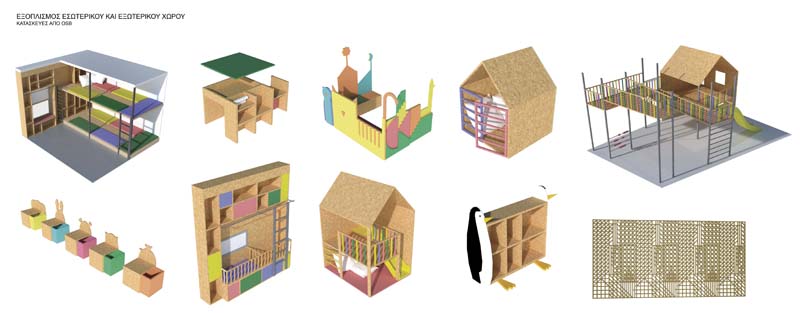

Usually more than half of any refugee population are children.
The present diploma project investigates the spatial dimensions of hosting and care of early childhood refugee children. The concept regarding the building program, embraces the main clauses and approach of the Guidelines for the Protection and Care of Refugee Children by the UNHCR, issued in 2004. The selected building site is located in the center of the city of Volos, neighboring two existing school complexes.
The necessary spaces for a kindergarten are combined in the project, with a small Community Center for Refugees, enhancing close contact between children and their parents, as well as, members of their community.
The main concept, regarding the architectural form of the building, is based on two spatial elements /patterns that finally defined its physical design. Both are relevant to the structure and morphology of the vernacular Islamic Mediterranean house.
In the proposed building, the structure and form of its volumes point to the typology of the traditional Islamic house with atrium, a building type well adopted to the local climate. Vernacular courtyard houses are well integrated in the organic urban fabric of Islamic settlements. Their plan is defined by the irregular street patterns, while inner courtyards tend to have a more regular orthogonal shape. The outer shell of these houses are pierced by small openings, protected by perforated wooden panels (mushrabiyas) that filter light, contrasting the surfaces of plain walls and protecting the privacy of family life.
These two elements were both deployed in the design of the present project. They determined the actual form of the building volumes and their relationship to the urban fabric, while exterior facades were designed using the idea of small openings protected with perforated decorative wooden panels. Allusions to the vernacular Islamic house are applied freely in the design of the present project, investigating their reinterpretation.
The low- cost interior design, of all needed infrastructure, enhances the feeling of a personal and unique space for the children that will be hosted and cared for in this kindergarten.
The main objective of the project is to provide a viable space for children while improving everyday life for their parents.
Supervisor: Papadopoulos Spiros
Reference Number: 655


In the context of the previous analysis, it is proposed an infrastructure for the archipelago as defined by Cacciari and Bataille, an infrastructure for "experiencing", reproducing the wave and enhancing it as a kind of hedonism, enjoying the “Dual Sun”, departure and return, disconnection and reconnection, the celebration of the place and the freedom from it. An infrastructure of falling inside and outside of it. The coherent line supporting the proposal is analyzed as follows; from the landscape to the fall of Icarus and the metaphysics of the archipelago, from the creation of the difference in the element of water to Smithson's earthworks which returns to us through the way of his death back to the landscape and fall.
This infrastructure consists in the design of a network of semi-open residential jetties 200 meters away from the land. The choice of the breakwater has a reference to Robert Smithson's work and is believed to be able to better support the concept of the archipelago as a construction blocking the horizon, protecting the landscape and thus forcing the archipelago to appear as a reaction to the existence of these structures. Their program concerns the habitation and enjoyment of the liquid element and the different types of water produced inside the infrastructure. The basic tool for the production of the space is the section, as the main mechanism of creating the difference, the taming of the wild liquid element and its categorization into common, public and private.
Supervisor: Paniyiris Costis
Reference Number: 637


The Diploma thesis proposes the design of a settlement, in the country of Ethiopia, and in particular in the Southern Nations, Nationalities, and Peoples' Region, which develops below the ground level. The settlement is divided into two levels, at -7 and -3.5 meters, and includes: 266 residences of 50 square meters each, a medical center, a school, a council center / administration, four temples for the practice of the four prevailing religions in the area, stores and shopping areas, a public showering building, shelters for cattle, sheep and goats, a mill and a slaughterhouse. Its placement below ground level is proposed in order to provide the best energy benefit in terms of maintaining thermal comfort, while in the design part it ensures minimal visual interference with the environment. The central point of design is the empty spaces (courtyards, square) around which the individual building blocks are developed. The motivation to select the country of Ethiopia has been a government program for the resettlement of populations, which for 30 years has forced the relocation of entire villages from the northern parts of the country to the south and south-west, with the pretext of the better cultivation possibilities and the more fertile lands of the new location. Lastly, it is recommended to use photovoltaic systems and water collection systems for the maximum possible autonomy of the settlement.
Supervisor: Kanarelis Theoklis
Reference Number: 657


The fu- TOURISM project is a scenario of tourist residence in one of the Cyclades islands, directed to old age retirees that come from northern countries, who now are looking for a relaxed and enjoyable daily life at the mild climate of the south, through their longer-term residence there. In the concept, this kind of habitation is considered as a reward, while the structure itself encloses a sense of redundancy. The euphoria of visitors initially derives from the natural landscape and the ideal climate and then is completed with the use of technological applications.
Supervisor: Mitroulias Giorgos
Reference Number: 626


The current thesis discusses the restoration of production in the city and its inclusion in an existing structure of the urban landscape, aiming at the empowerment of the local economy and the needs of the city, due to the high rates of unemployment and the financial crisis that afflicted Greece. Initially, a research is conducted about the Greek reality and the innovation levels, including the necessities of the contemporary businesses for state-of-the-art technology. Furthermore, the concept of fabrication laboratory (fab lab) and hub is presented, while analyzing their contribution to the primary sector and the fact that they compose an environment that stimulates interaction, experimentation and the materialization of ideas. In addition, we highlight their social work and state examples of such places found in the Greek region. The research is enriched with a series of terms and movements, which are related to the free distribution of knowledge, through hacking an already existing service to create new, more useful to the society, through the culture of DIY and maker culture that foster the use of any available means, in order to resolve a current difficulty.
As an outcome of this research, we located and chose an existing structure in Thessaloniki, which could engulf those functions that will amplify the local productivity and economy. Our building of interest is an empty urban cell that has been abandoned, due to the financial crisis. It stands as a live testimony of the depression and demands delicate approach that will operate as a solution to the current situation. For this reason, we insert the function of a fab lab and a hub. Our intention is to provide the essential tools one needs to materialize free his ideas. We design production, working and learning spaces that promote the democratization of information and production. Moreover, newly created enterprises (start-ups) are given the chance to obtain their own, low cost, working space, where they can interact with larger companies, thus creating an ambience of collaboration and solidarity.
Supervisor: Kotionis Zissis
Reference Number: 643


The Industrial Revolution, driven by oil and other fossil fuels, leads to a dangerous end: energy and food prices have skyrocketed, unemployment remains high, private and public debt are rising, and also unemployment is rising. Recovery of the economy is delayed. Faced with the prospect of a second collapse of the global economy, humanity is desperately seeking a viable economic plan for the future. This diploma thesis attempts to outline this new economic model through the design of a series of fully prefabricated shells of life. Different installation scenarios have been studied in various geographies as well as the possibility of endless multiplication of these, depending on the needs of the users. Internet technology and renewable energy converge to create the "Third Industrial Revolution". What is exciting is the idea of hundreds of millions of people to produce their own green energy in their homes, offices and factories and share it with each other through an "energy Internet" in exactly the same way we now create and share Information on the Internet. In the same way people plan their dream homes when they are hosted on online platforms, turning them into active members in the design. Finally, the present work brings shape and life to a small population settlement, which will be able to be installed in any place anywhere, as it is born from the aforementioned prefabricated shells. If you consider some of the challenges of our time, such as the growing population, increasing urbanization, lack of resources, the growing global food crisis, and reducing global CO2 emissions, a settlement combining the best features of urban life and living in the countryside, within the framework of a harmonized future society, is a necessity.
Supervisor: Stylidis Iordanis
Reference Number: 634


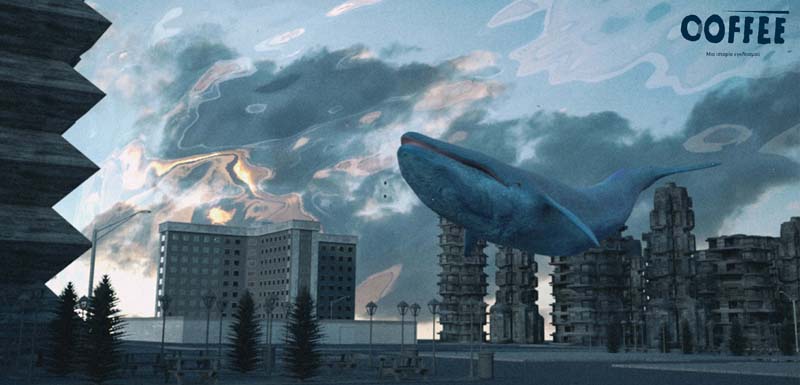





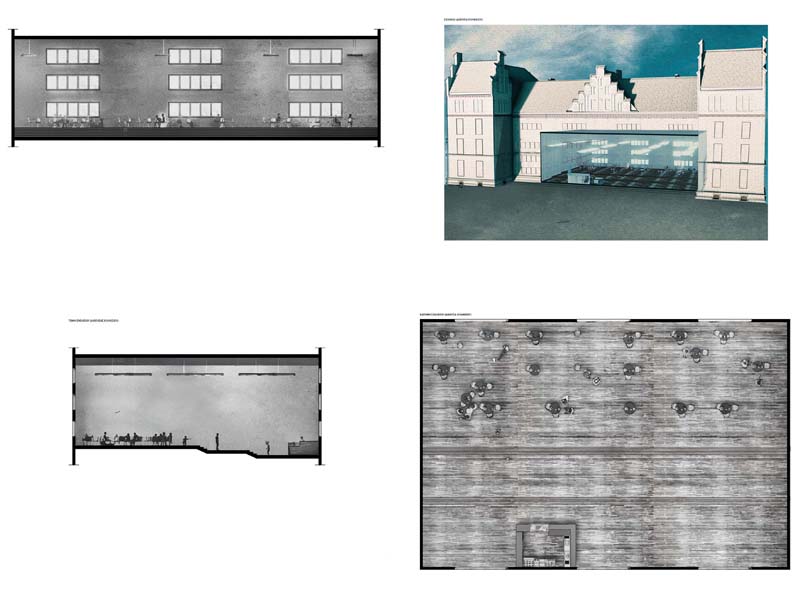

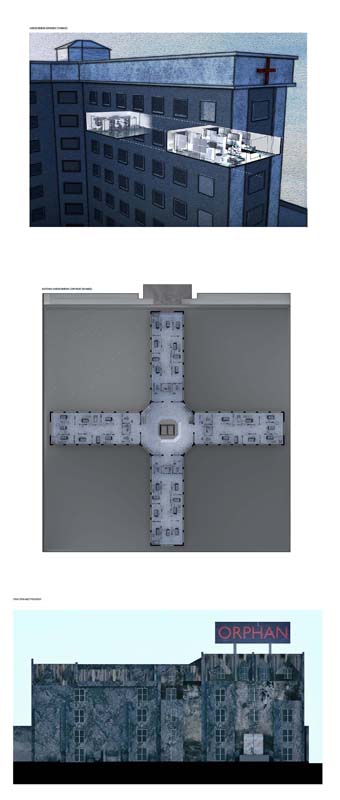

This Animation wants to show forms of power that exist in the everyday life of people. All as productive members of the economic system, we produce economic benefits that we can not consume or enjoy either due to lack of free time or due to tax etc. Each member suffers from the so-called institutionalization, that is, the inner fear that creates impotence and makes it unlikely a change-pause-disengagement from a daily routine that does not serve any need of a social member beyond survival. If we try to break these seeming chains, our future as social members is ominous. The above situations do not differ much from the everyday life of a prisoner, who works for economic gains of state mechanisms respectively, has no choice to resist what is imposed on him and suffers from institutionalization. The state daily interferes with human life through various mechanisms such as education, military service, self-discipline, the ubiquitous panoptism that seemingly struggles to identify the unregulated, non-disciplined individual. They all emphatically espouse the above situations by making the difference as a defect. So how do institutions of imprisonment not be widely accepted when they are familiar pathways that are visible on a daily basis as they are imposed as mechanisms of transformation of individuals. As long as life in the state is the only scenario, Closure and Isolation mechanisms will stigmatize and undermine diversity.
Supervisor: Papadopoulos Spiros
Reference Number: 636


